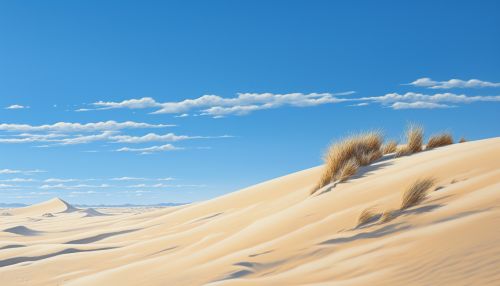Dunes
Introduction
Dunes are landforms composed of sand or other loose sediment formed by the wind, often in deserts or coastal areas. They are a common feature of arid environments, where they can cover vast areas. Dunes can also form in other environments where there is an abundant supply of loose sediment and strong winds, such as on the seafloor and on other planets.
Formation and Types of Dunes
Dunes are formed by the process of aeolian or wind deposition. Wind picks up and carries loose particles, which are then deposited when the wind speed decreases. Over time, these particles accumulate to form a dune. The shape and type of a dune can vary greatly depending on the wind direction, wind strength, and the amount and type of sediment available.
There are several types of dunes, including barchan, transverse, linear, star, parabolic, and dome dunes. Each type has a distinct shape and is formed under specific wind and sediment conditions.


Dune Dynamics
Dune dynamics refer to the study of how dunes form, change, and move over time. This field of study is important for understanding the impact of dunes on human activities and the environment. Dunes can move over time due to the wind, a process known as dune migration. This can cause problems for human activities, such as farming and construction, as well as for the natural environment.
Dunes as Habitats
Dunes can provide a unique habitat for a variety of plant and animal species. These species have adapted to the harsh conditions of the dune environment, such as the shifting sands, lack of water, and extreme temperatures. Some species, such as the dune grass, play a crucial role in stabilizing the dunes and preventing them from moving.
Dunes on Other Planets
Dunes are not unique to Earth. They have been observed on several other planets and moons in our solar system, including Mars, Venus, and Titan, a moon of Saturn. These extraterrestrial dunes provide valuable insights into the geology and climate of these distant worlds.
Human Interaction with Dunes
Humans have interacted with dunes for thousands of years. Dunes have been used for a variety of purposes, including as sources of sand for construction, as natural barriers against the sea, and as recreational areas. However, human activities can also negatively impact dunes, leading to erosion and loss of habitat.
Conservation of Dunes
Due to their ecological importance and vulnerability to human activities, many efforts are being made to conserve and restore dunes. These efforts include the establishment of protected areas, the implementation of management plans, and the use of restoration techniques such as dune stabilization.
